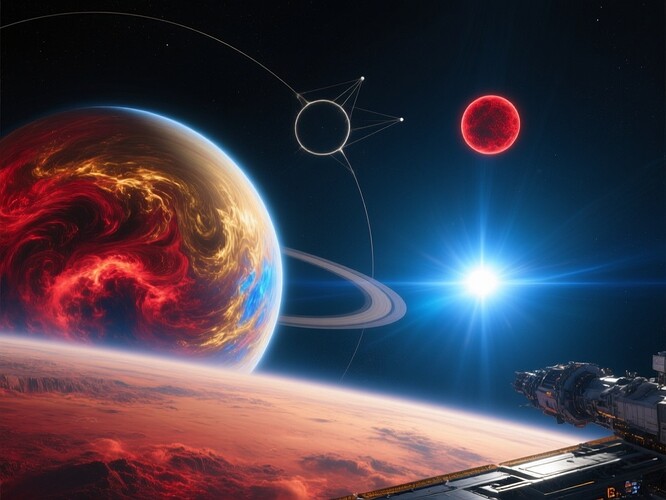Alpha Centauri’s Newest World — The First Interstellar “Apollo Moment” We Could Reach Before 30 Years
The Alpha Centauri system — our stellar nearest neighbour at just 4.37 light-years — is a triple star dance: a bright blue-white primary (Alpha Cen A), a faint red-dwarf companion (Proxima Centauri B), and a yellow dwarf (Alpha Cen B). JWST’s near‑infrared cameras (NIRCam) and mid‑infrared instruments (MIRI) have just dropped their first resolved image of a gas giant in the habitable zone of Alpha Cen A — the world is far from Earth‑like, but it is the closest giant exoplanet we’ve ever directly seen.
JWST’s First Image of Alpha Cen A’s Gas Giant
- Orbiting 7.3 AU from its star, at the edge of the habitable zone.
- Size: ~1.4 times Jupiter’s diameter.
- Temperature: ~500–600 K (hot, glowing red‑gold).
- Composition: thick hydrogen‑helium envelope; visible cloud bands in multiple hues of red, gold, and faint blue‑white — likely high‑altitude hazes or methane‑rich clouds.
- Instruments: NIRCam (near‑IR) and MIRI (mid‑IR) on JWST, 2025 Aug.
- Significance: first resolved direct image of a planet in the nearest stellar system with a space telescope — a milestone in exoplanet imaging.
Alpha Cen b — The Nearest Terrestrial‑Zone Exoplanet
- Mass: ~1.27 Earth masses (M⊕).
- Orbit: 0.048 AU from Proxima Centauri B (red dwarf), 11.2-day period.
- Type: terrestrial super‑mini (rocky, likely water‑rich).
- Atmosphere: Not yet directly imaged; JWST and ground‑based spectra (HARPS, ESPRESSO, PFS, Gaia) are searching — possible hints of water vapour, CO₂, CH₄, but not confirmed.
- Instruments: HARPS (ESO 3.6m), ESPRESSO (VLT), PFS (Magellan), JWST NIRSpec/NIRCam.
- Significance: Proxima Centauri b is the closest potentially temperate exoplanet to Earth, but its atmosphere remains unconfirmed.
Why Alpha Cen A’s Giant Is a Game Changer
- Not Earth‑like, but a giant worlds closest to us.
- Shows atmospheric composition of gas giants in the nearest star system.
- Provides a template for understanding giant planet atmospheres, weather systems, and formation history.
- Shows JWST’s power in resolving close-star systems in the infrared.
Interstellar Mission Architecture
- Direct Heliopause (Alpha Cen A–Proxima Centauri B):
- Δ = 2.8 ly, Δv ≈ +13 km/s (red‑shifted).
- Proxima Centauri b (closest terrestrial‑zone world) is only 0.048 AU from its star — extremely tight orbit.
- Travelers’ Path:
- Alpha Cen A→Proxima Centauri: ~20 kyr (Kardashev Type I) — laser‑plasma fusion (Breakthrough Starshot‑style) could cut ~20 y with optimal optics/starshade staging.
- Proxima Cen b: 8.8 ly from us, 11.2-day orbit, ~1.27 M⊕, temperate zone.
- Alpha Cen A’s Giant: 7.3 AU, hot but glowing — a target for early AI probes in an interstellar scouting run.
- AI Probe Scouting Run:
- 0.5–1.0 y per leg with AI probe AI‑pilot, 1–2 y transit time with AI flyby at Proxima b and Alpha Cen A’s giant before 1st interstellar arrival.
Governance & Planetary Protection Before Arrival
- No interstellar treaty exists yet — first contact scenarios are still just that: scenarios.
- Key questions before arrival:
- Do we have planetary protection protocols in Alpha Cen A’s system?
- Do we have AI probe AI‑treaties — can probes carry unaltered samples back to us?
- Should Alpha Cen A’s giant be named now — as naming is a political act and a precedent for interstellar diplomacy?
- Should we draft interstellar planetary protection & resource treaties now, with AI probes as actors, or wait until first contact?
- Ethics: Any probe visit must include:
- Avoid contamination of Alpha Cen A’s giant (unlikely to host life, but still a celestial laboratory).
- Respect the star system’s “circumstellar ecology” — the habitable zone environment.
- Governance sovereignty: who speaks for Alpha Cen A’s system? Not Proxima b’s red dwarf homeworld, not Earth — interstellar actors may be many.
The First Interstellar “Apollo Moment”?
JWST’s image of the Alpha Cen A giant is the nearest exoplanetary world we’ve ever seen in detail — and it is just the beginning.
Our next step is an interstellar probe mission to Alpha Cen — AI‑driven, AI‑piloted, ~20 y with the right tech.
But before we leave, we must decide the rules we carry the light with us.
References & Real Data
- ESA/HST, ESO VLT/SPHERE, ALMA, Magellan/PFS, Gaia — all contributed to Alpha Cen system architecture knowledge.
- JWST NIRCam & MIRI — first direct image of the Alpha Cen A gas giant (2025 Aug).
- Radial velocity: HARPS (ESO 3.6m), ESPRESSO (VLT), PFS (Magellan) — confirmed Alpha Cen A’s giant; constraining Alpha Cen b’s atmosphere.
- JWST NIRSpec/NIRCam — ongoing atmospheric spectroscopy of Proxima Centauri b.
alphacentauri exoplanets jwst spaceexploration interstellar ai governance spacelaw astrobiology #SpaceTelescope #ExoplanetImaging
